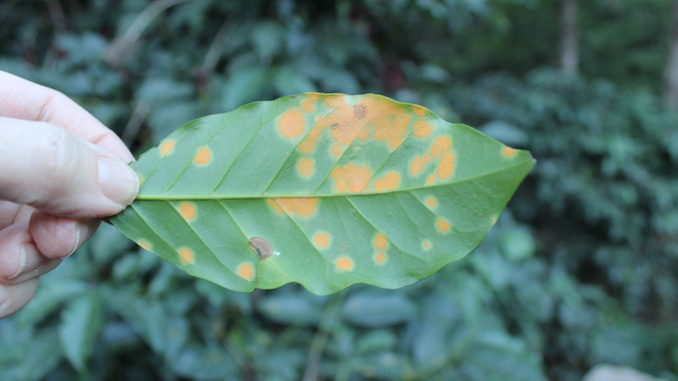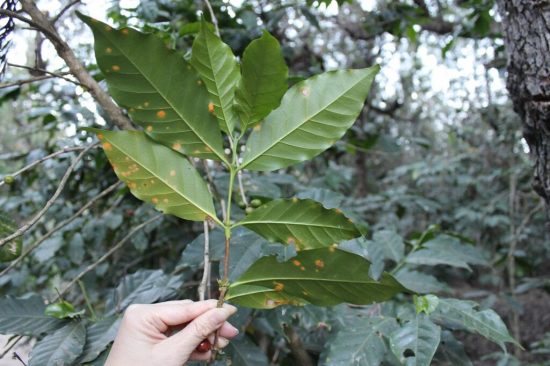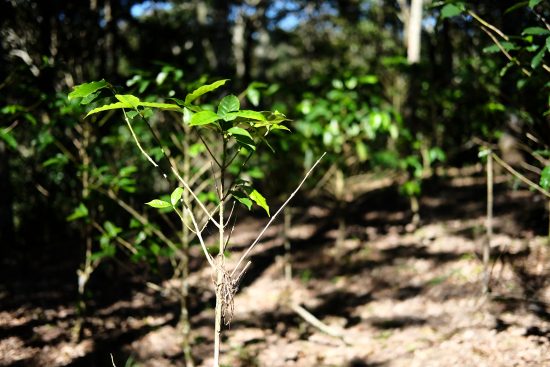
The USDA-led work on coffee leaf rust will conduct trials of rust-resistant varieties and much more.
BY CHRIS RYAN
BARISTA MAGAZINE ONLINE
Feature photo courtesy of World Coffee Research
Coffee leaf rust is an airborne fungal disease that has been impacting coffee-growing communities for centuries. More recently, the disease reminded the specialty-coffee community of its existence when a leaf rust epidemic hit Latin America in the first part of the last decade. In 2020, leaf rust continued to plague coffee growers, this time in the U.S.—when the disease was discovered on the Hawaiian island of Maui.

A Grant Gifted to Hawaiian and Puerto Rican Farmers
While the spread of coffee leaf rust continues to present a potentially scary future for coffee production, work is taking place worldwide to combat the disease. Last week a new, major effort was announced: A four-year, $6 million grant—issued by the Specialty Crop Research Initiative (SCRI) of the U.S. Department of Agriculture’s National Institute of Food and Agriculture (NIFA)—will support coordinated research to address the threat of coffee leaf rust for coffee farmers in Hawaii and Puerto Rico.
The partners will work with a consortium led by the Synergistic Hawaii Agriculture Council (SHAC), and the grant will have five main objectives:
- Conducting field trials of rust-resistant varieties
- Surveying spread and identifying field management options for farmers to use to protect existing coffee trees
- Identifying fungicides or biological control methods to combat CLR
- Doing economic analyses of U.S.-grown coffee from both a growing and a selling perspective
- Expanding genomic research to assist the global coffee industry in understanding and combating the fungus.
Helping a Global Community Fight Coffee Leaf Rust
While the grant will focus on coffee leaf rust work in Hawaii and Puerto Rico, its findings are expected to help the global coffee community combat leaf rust. “It is incredible and important to see the U.S. stepping up investment for research on coffee’s most devastating disease,” says Jennifer “Vern” Long, CEO of World Coffee Research, which is supporting the project. “This work will benefit not only Hawaiian and Puerto Rican growers, but will lead to insights and innovations that impact coffee farmers everywhere.”
What Kind of Research Is Happening on Coffee Leaf Rust?
Understanding coffee leaf rust genetics benefits the entire industry. Included in the grant will be funding to rust expert Prof. Catherine Aime of Purdue University, for the sequencing and assembly of the coffee leaf rust (H. vastatrix) genome. It will also aid her in the development of methods for genetically identifying rust races, as well as the identification of genes associated with virulence.
Such advances could lead to new and cheaper methods of testing for different races of rust, and innovations in managing rust and breeding for rust resistance. Race typing, in particular, is essential for incorporating rust-resistant varieties in the field; scientists still do not know the element that resistant varieties use to combat rust.
Catherine’s work—specifically, using the rust genome sequence to then identify markers associated with the different rust races—holds particular promise, says WCR communications director Hanna Neuschwander. “If this can be done (and she thinks it can), it might allow the introduction of a rapid, cheap DNA test to find out what race of rust is present in an outbreak, which would help decision-makers figure out how to respond effectively,” says Hanna. “Unbelievably, this actually isn’t possible right now.
”This is critical because some varieties are resistant to some races of rust, but not others,” Hanna continues. ”There is no easy way, however, to learn what race of rust is present in a region—meaning countries could, at scale, be deploying inappropriate varieties.”

How Will This Benefit the Future of Coffee?
Gaining a better understanding of this could dramatically change prospects for breeding new resistant varieties in the future. The NIFA adds to another recently announced grant from the Foundation for Food & Agriculture Research (FFAR), and early support provided by World Coffee Research. It shows the importance of investing in advanced research to understand one of coffee’s most destructive pathogens.
In addition, the Hawaii delegation introduced the Coffee Plant Health Initiative Amendments Act earlier this year that would expand research funding to address all current and emerging threats to coffee plant health, including CLR.
In the shorter term, the grant provides funding to test existing rust-resistant varieties in Hawaii and Puerto Rico. Both will join World Coffee Research’s International Multilocation Variety Trial (IMLVT), which will be managed by USDA. As with other countries participating in the IMLVT network, local scientists, growers, and industry members will jointly evaluate the agronomic and quality performance of varieties. Trial participants can negotiate for access to conduct additional research and possible commercialization of promising varieties.
“Testing these international varieties gives our growers a leg up on finding long-term solutions that work in the field,” says Suzanne Shriner, SHAC executive director and coffee farmer, in the press release. “And in the immediate term, applied research will help maintain nonresistant tree health and support the agricultural economies of our islands.”


